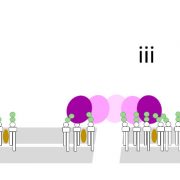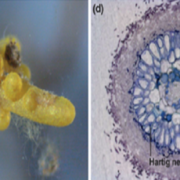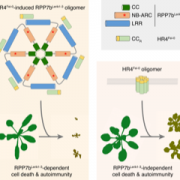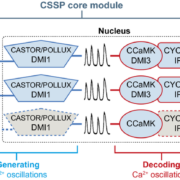Leaf yellowing phenotype in rice, mediated by phytoplasma-secreted effector protein, attracts insect vectors
 Phytoplasmas are bacterial pathogens that induce significant morphological changes in a host plant including prominent leaf yellowing. They are known to be transmitted by piercing-sucking insects or phloem-feeding arthropods. Phytoplasmas alter plant developmental process through specific effectors. In a study by Zhang et al., an effector protein secreted by rice orange leaf phytoplasma (ROLP) induced leaf yellowing in rice plants. This effector protein, secreted ROLP protein 1 (SRP1), is secreted from ROLP in the infected rice phloem region and translocates to adjacent chloroplasts where it directly targets and negatively regulates the expression of rice glutamine synthetase (OsG2). OsG2 is essential for biosynthesis of chlorophyll precursors, so its impairment by SRP1 causes a leaf yellowing phenotype. Insect two-choice assays revealed that SRP1 overexpression in rice transgenic plants promotes attractiveness for leafhopper pests that transmit ROLP and facilitates ROLP infection into rice phloem. By attracting insect vectors, leaf yellowing is beneficial for ROLP transmission. This is the first study to demonstrate phytoplasma-induced leaf color change attracts arthropod vectors in rice. (Summary by Indrani Kakati @Indranik333) PNAS 10.1073/pnas.2402911121
Phytoplasmas are bacterial pathogens that induce significant morphological changes in a host plant including prominent leaf yellowing. They are known to be transmitted by piercing-sucking insects or phloem-feeding arthropods. Phytoplasmas alter plant developmental process through specific effectors. In a study by Zhang et al., an effector protein secreted by rice orange leaf phytoplasma (ROLP) induced leaf yellowing in rice plants. This effector protein, secreted ROLP protein 1 (SRP1), is secreted from ROLP in the infected rice phloem region and translocates to adjacent chloroplasts where it directly targets and negatively regulates the expression of rice glutamine synthetase (OsG2). OsG2 is essential for biosynthesis of chlorophyll precursors, so its impairment by SRP1 causes a leaf yellowing phenotype. Insect two-choice assays revealed that SRP1 overexpression in rice transgenic plants promotes attractiveness for leafhopper pests that transmit ROLP and facilitates ROLP infection into rice phloem. By attracting insect vectors, leaf yellowing is beneficial for ROLP transmission. This is the first study to demonstrate phytoplasma-induced leaf color change attracts arthropod vectors in rice. (Summary by Indrani Kakati @Indranik333) PNAS 10.1073/pnas.2402911121









